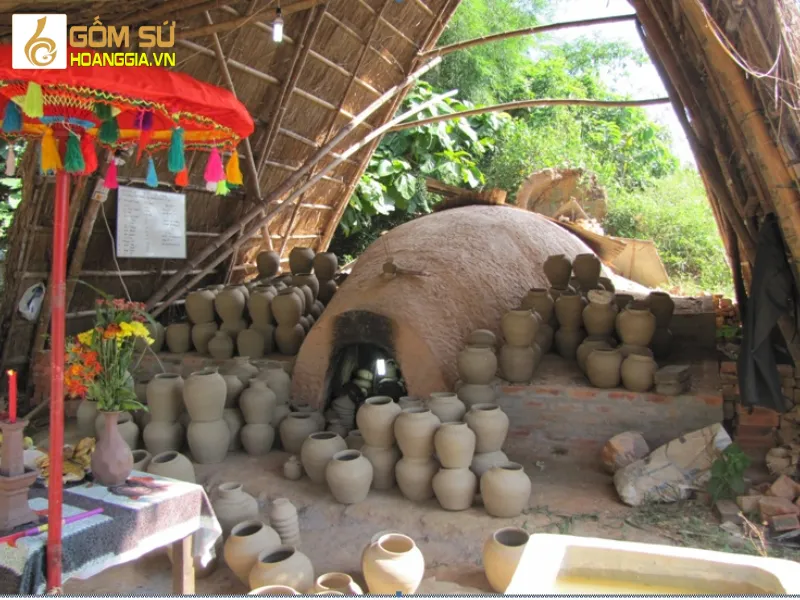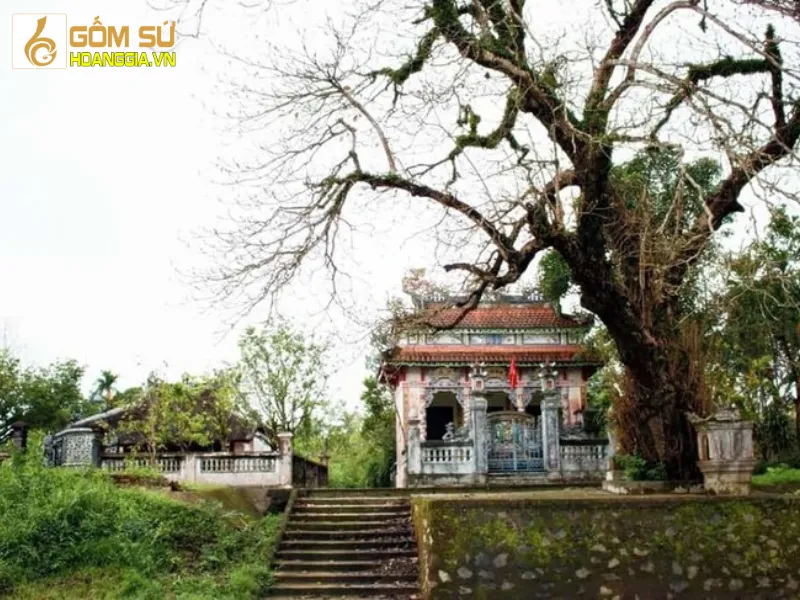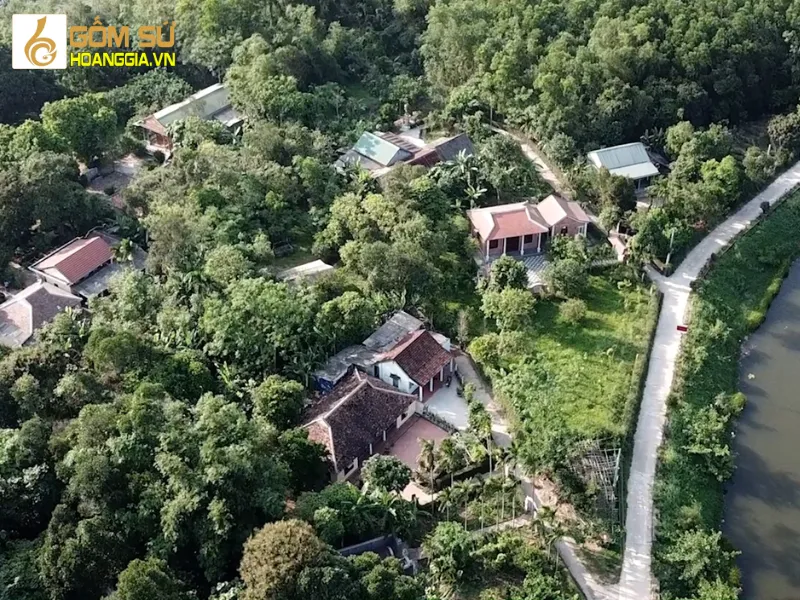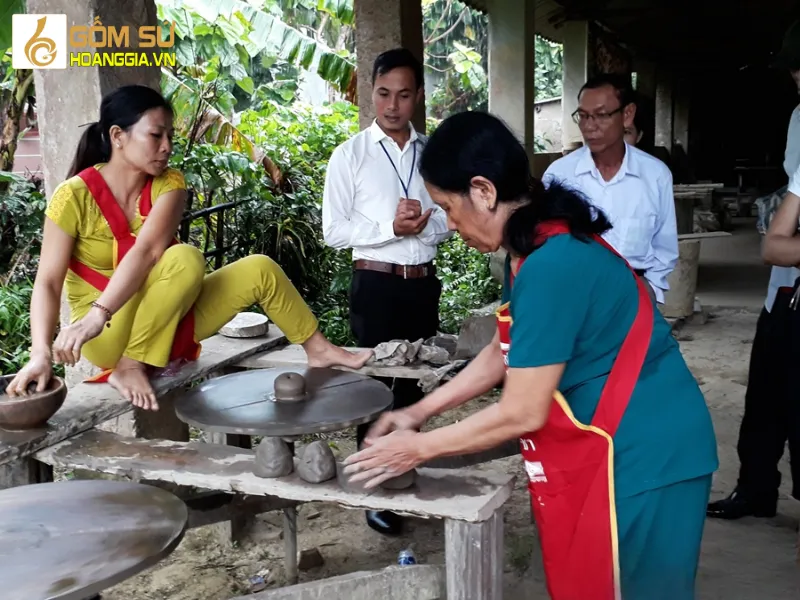Phuoc Tich Pottery Village, a hidden gem nestled beside the gentle O Lau River, has long been an attractive destination for tourists due to its ancient beauty and unique traditional cultural values. This place not only captivates visitors with its peaceful rural scenery and ancient Ruong houses but also with the renown of its “royal tribute” pottery craft, a quintessence of the ancient capital of Hue. Join “Travel the World” to explore the unique beauty and exciting experiences at Phuoc Tich Pottery Village, a must-visit destination on the map of Central Vietnam tourism.
Introducing Phuoc Tich Pottery Village
Phuoc Tich Pottery Village is located in Phuoc Phu hamlet, Phong Hoa commune, Phong Dien district, Thua Thien Hue province. Situated about 40km north of Hue city center, this ancient village appears like a tranquil painting, separate from the hustle and bustle of urban life. Embraced by the O Lau River on nearly two-thirds of its area, Phuoc Tich has a unique shape resembling a wine jar or a horseshoe when viewed from above.
With a history of nearly 500 years, Phuoc Tich Village is not only a purely ancient village but also a living cultural heritage. In 2009, the village was honored to be recognized by the State as a National Monument, affirming its unique historical, cultural, and architectural values. This place is likened to a “living museum” preserving the pristine beauty of a Vietnamese village with ancient banyan trees, wharves, communal houses, and especially the famous traditional “royal tribute” pottery craft.
In 2014, the People’s Committee of Thua Thien Hue province officially recognized Phuoc Tich Pottery Village as a traditional craft village, marking a new step in preserving and promoting the value of pottery here. Coming to Phuoc Tich, visitors not only admire the ancient beauty of a Vietnamese village but also have the opportunity to learn about the history, culture, and experience the unique features of a traditional pottery craft that has existed for centuries.
History of Formation and Development of Phuoc Tich Pottery Village
The history of Phuoc Tich Pottery Village is closely linked to the land reclamation and development of the ancient Thuan Hoa – Phu Xuan region. According to historical records, the village was formed around 1470, during the reign of King Le Thanh Tong. Through many historical ups and downs, Phuoc Tich has maintained its position as an important pottery production center, especially flourishing under the Nguyen Lords and the Nguyen Dynasty.
The name “Phuoc Tich” means “accumulated blessings,” expressing the desire for prosperity and luck of the local people. Phuoc Tich pottery craft is believed to have originated from Thanh Hoa, by pottery artisans who migrated from this land and settled down. With abundant clay resources from the land along the O Lau River, along with unique pottery making techniques, Phuoc Tich people have created high-quality pottery products, famous throughout the region.
During its golden age, Phuoc Tich Village had up to 12 pottery kilns operating day and night, with smoke and fire covering the whole area. Phuoc Tich pottery products not only served the daily needs of local people but were also supplied to the Hue Citadel and neighboring provinces. In particular, Phuoc Tich pottery is famous for its “royal tribute” products, carefully selected to serve the royal family, thereby further spreading the village’s reputation.
However, in the late 20th century, Phuoc Tich pottery craft gradually declined due to competition from industrial pottery products and market fluctuations. By 1995, the last pottery kiln in the village also ceased operations, and the traditional pottery craft seemed to be fading away.
But with the efforts of local authorities, dedicated artisans, and the community’s interest, Phuoc Tich pottery craft has gradually been revived. Since 2006, through the Hue Festivals and tourism promotion activities, Phuoc Tich craft village has been widely introduced to domestic and international tourists. Many pottery kilns have been restored, and Phuoc Tich pottery products have been increasingly improved in design and quality, meeting the needs of the tourism market and modern consumers. Today, Phuoc Tich Pottery Village is not only a traditional craft village but also an attractive cultural tourism destination, contributing to preserving and promoting the heritage values of the ancient capital of Hue.

Location and How to Get to Phuoc Tich Pottery Village
Phuoc Tich Pottery Village is located in a fairly convenient position for travel and sightseeing. From the center of Hue city, visitors can easily reach the village by various means of transport:
- Motorbike: This is a popular means of transport and is chosen by many tourists for its flexibility and initiative. From Hue, follow National Highway 1A northwards for about 40km, to near My Chanh bridge (Hai Lang district, Quang Tri), then turn right onto National Highway 49B. Continue for about 1km across the bridge spanning the O Lau River to reach Phuoc Tich village. The route is quite easy and there are many signposts.
- Taxi/Car: If traveling in groups or families, taxi or car is a comfortable and convenient option. Travel time from Hue to Phuoc Tich is about 45-60 minutes.
- Bus: You can also take a bus from Hue to Phuoc Tich, but it will take longer and you will need to walk a distance from the bus stop to the village.
In addition, if you want to combine visiting Phuoc Tich pottery village with other tourist attractions in Hue, you can hire a package tour car or a shared car to save costs.

Discovering the Unique Features of Phuoc Tich Pottery
Phuoc Tich pottery carries its own unique features, unlike any other pottery line in Vietnam. This uniqueness comes from the raw materials, crafting techniques, and family secrets preserved by Phuoc Tich artisans through many generations.
- Clay material: The clay for making Phuoc Tich pottery is taken from the land along the O Lau River, where the soil is special, pliable, and has high adhesion. This type of clay creates durability and heat resistance for pottery products.
- Pottery firing technique: Phuoc Tich pottery is fired using traditional manual methods in a “bau” kiln (beehive kiln). The kiln is built of bricks and earth, using firewood as fuel. The pottery firing process requires meticulousness, experience, and the ability of the artisan to adjust the fire temperature. The firing temperature of Phuoc Tich pottery usually reaches about 1200 degrees Celsius, helping the products to be evenly fired, have high durability, and characteristic colors.
- Colors and designs: Phuoc Tich pottery is famous for its characteristic dark brown color, created by a natural glaze from rice husk ash and clay. Besides, Phuoc Tich pottery also has other colors such as yellow, red, black, etc., depending on the firing technique and type of glaze used. Phuoc Tich pottery designs are diverse, from everyday household items such as pots, pans, kettles, cups, jars, vases, etc., to decorative products such as statues, reliefs, flower vases, etc.
- “Royal tribute rice cooking pot”: One of the most famous pottery products of Phuoc Tich is the “om” (pot) for cooking rice. Legend has it that Phuoc Tich pots have good heat retention, helping rice to cook evenly, be soft, fragrant, and not burnt. Therefore, Phuoc Tich pots were chosen as “royal tribute” items during the Nguyen Dynasty, becoming a symbol of the pottery village and the pride of the local people. The folk verse “Phuoc Tich pot cooks delicious emperor’s rice / Ha Tri lotus is as precious as Phu Xuan” has affirmed the special value of Phuoc Tich pottery products.

Unique Travel Experiences at Phuoc Tich Pottery Village
Coming to Phuoc Tich Pottery Village, visitors not only admire the scenery and take photos but also have the opportunity to experience many unique cultural and tourist activities:
Visiting Ancient Ruong Houses
Phuoc Tich Village is famous for its ancient Ruong houses, built in traditional Hue architecture. These houses are hundreds of years old, with mossy tile roofs, sturdy ironwood pillars, and sophisticated carved patterns. Visiting Ruong houses, visitors will learn about the traditional housing architecture of Vietnamese people, admire ancient artifacts, and hear interesting historical and cultural stories.

Exploring Religious Structures
Phuoc Tich Village also preserves many valuable historical and cultural religious structures such as the Cay Thi temple, where the Cham people’s goddess Ponagar is worshiped; clan temples, Doi temple, Phuoc Buu pagoda, Hon temple, etc. Visiting these structures, visitors will understand more about the spiritual life and beliefs of Phuoc Tich people and the traditional cultural values preserved through many generations.
Visiting Private Pottery Museum
The pottery museum of artisan Le Trong Dien is a must-visit destination for those who love Phuoc Tich pottery. Here, visitors will admire a precious collection of ancient pottery, with a full range of Phuoc Tich pottery products from its golden age to the present. The museum also displays traditional pottery tools and equipment and introduces the Phuoc Tich pottery production process.
Experiencing Pottery Making with Artisans
An interesting and meaningful experience when coming to Phuoc Tich is to participate in pottery making classes guided by local artisans. Visitors will be able to knead clay, shape products, and decorate them according to their preferences. This is a great opportunity to learn about traditional pottery craft, practice dexterity and creativity, and create unique souvenirs with personal imprints.
Enjoying Local Cuisine
In addition to pottery craft, Phuoc Tich is also famous for many local specialties with homeland flavors. Visitors can enjoy traditional cakes such as Phu The cake, La Gai cake, Khoai Tia cake, etc., made from natural ingredients and processed according to family recipes. In particular, Bong Cay cake, a unique royal tribute cake, is also a delicacy that visitors should not miss when coming to Phuoc Tich.
Suggested Itinerary for Phuoc Tich Pottery Village Tour
To have a complete and meaningful Phuoc Tich pottery village tour, you can refer to the following suggested itinerary:
- Morning:
- Arrive at Phuoc Tich village, visit ancient Ruong houses, learn about the architecture and history of these houses.
- Visit religious structures such as Cay Thi temple, Phuoc Buu pagoda, etc.
- Visit the pottery museum of artisan Le Trong Dien.
- Noon:
- Enjoy local cuisine at restaurants in the village or local houses.
- Afternoon:
- Participate in a pottery making class with artisans.
- Cycle around the village, enjoy the scenery of rivers and peaceful countryside.
- Buy Phuoc Tich pottery souvenirs at shops in the village.
You can spend a day or half a day exploring Phuoc Tich pottery village, depending on your time and preferences.

Important Notes When Traveling to Phuoc Tich Pottery Village
To make your Phuoc Tich pottery village trip smooth and memorable, you need to note a few things:
- Weather: The weather in Hue is quite hot in the summer and rainy in the winter. It is best to choose to travel in spring or autumn to have cooler and more pleasant weather.
- Dress code: You should choose comfortable, polite clothes, suitable for visiting rural villages and cultural and religious structures.
- Money: You should bring cash to spend on sightseeing, eating, and shopping in the village.
- Luggage: You should bring a hat, sunscreen, drinking water, and snacks if needed.
- Respect local culture: When visiting the village, please respect the customs, habits, and culture of the local people. Maintain general hygiene, do not litter, and do not make noise or cause disorder.
- Support local people: Buy pottery products and other handicrafts of the village to support and contribute to local economic development.

Conclusion: Phuoc Tich Pottery Village is not only an attractive tourist destination but also a precious cultural heritage of Vietnam. Coming to Phuoc Tich, visitors will immerse themselves in the peaceful space of the village, discover unique traditional cultural values, and experience the unique features of the famous “royal tribute” pottery craft. Come and feel the beauty and hospitality of Phuoc Tich pottery village, you will surely have unforgettable memories!